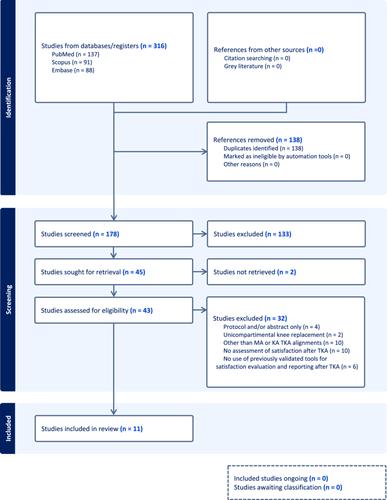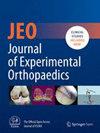The purpose of this systematic review was to compare patient satisfaction patient-reported outcomes (PROMs) levels after mechanically aligned (MA) and kinematically aligned (KA) total knee arthroplasty (TKA).
A systematic literature search following PRISMA guidelines was conducted on PubMed, Embase, Medline and Scopus to identify potentially relevant articles for this review, published from the beginning of March 2013 until the end of October 2023. Only articles reporting satisfaction after KA TKA, MA TKA or both were included, which use valid and reliable tools for the evaluation and reporting of satisfaction after TKA. Title, authors, year of publication, study design, level of evidence, follow-up period, patients' demographic data, sample size, type of satisfaction score, postoperative satisfaction score, postoperative alignment, statistical significance, as well as other variables, were extracted for analysis. An Agency for Healthcare Research and Quality's (AHRQ) design-specific scale was used for assessing randomized control trials (RCTs). The nonrandomized control trials were evaluated by using the Joanna Briggs Institute's (JBI) Critical Appraisal Tool. The Newcastle-Ottawa Scale (NOS) was also used to assess cohort studies, while case series were evaluated using the NIH Quality Assessment Tool for Case Series Studies.
The initial search identified 316 studies, of which 178 were considered for screening. Eleven studies completely fulfilled the inclusion criteria, including one RCT, five nonrandomized control trials/quasi-experiments, three case series, and two cohort studies. The total number of patients recruited for MA TKA was 1740. Conversely, 497 patients were enrolled for KA TKA. Five studies used the visual analogue scale (VAS) for assessing postoperative patient satisfaction, four used the Knee Society Score (KSS) 2011 version and two Likert-based types of scores. Overall, the highest mean satisfaction score of KSS 2011 was 31.5 ± 6.6 in the MA group, and 29.8 ± 80 in the KA group in four studies. All of them showed high postoperative patient satisfaction rates for both MA and KA TKA, but with no statistically significant difference between them (p > 0.05).
Both mechanically aligned total knee arthroplasty, as well as kinematically aligned total knee arthroplasty led to high rates of postoperative patient satisfaction, with no statistically significant differences between them.
Level III, systematic review.



